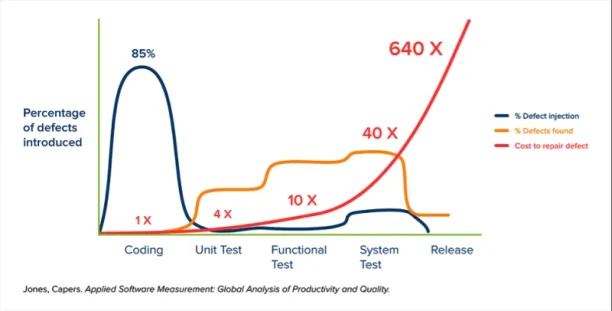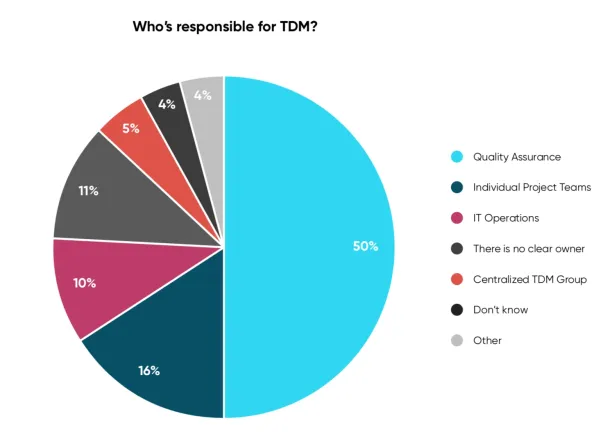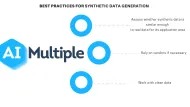Test Data Management: What it is & Why it matters in 2024?
Test data management (TDM) is a critical process in the testing lifecycle. It helps businesses
- optimize effort spent to generate test data and run tests, leading to a faster test process,
- maintain the quality of their products,
- protect the privacy of sensitive information regarding the enterprise or its clients
What is test data management?
Test data management consists of creating nonproduction data sets that fulfill the quality requirements of software quality-testing while maintaining the privacy of data.
Why is the test data management important?
Test data management market is expected to grow 12.7% CAGR. In Software Development Life Cycle (SDLC), the testing stage is where product defects are reported, tracked, fixed and retested, until the product reaches the quality standards. An effective test data management is essential for software development process because:
- It reduces products’ time-to-market. An effective test data management consists of automated testing that helps the process function quickly and efficiently.
- According to studies, the cost of not fixing defects increases exponentially in each stage of software development life cycle. Therefore, the quality of software should be tested to fix errors earlier.

- Due to data privacy regulations such as GDPR, test data management is crucial because it helps businesses comply with regulations thanks to compliance analysis and data masking techniques.
- Effectively managing test data helps businesses avoid storing too many copies of test data. Therefore it reduces the complexity of data management.
What does the test data management process look like?
An appropriate test data management process has 5 stages:
Planning
In the planning stage, testing teams plan the list of tests, identify the data requirements of each test, and prepare the necessary documentation.
Analysis
Software testing teams collect and consolidate data requirements. Decisions regarding data backup, access, and storage are made during the analysis phase.
Design
This stage is the final step before implementing the test data management strategy. In this stage, teams design the strategy for data preparation; they can choose to generate synthetic data or, clone or subset production databases for testing purposes. Businesses should identify data sources, data providers, and the environment that needs data to be loaded or reloaded.
Build
The building stage is where businesses implement strategies they planned. Data is backed up, and data masking is performed if the team decided that it is necessary.
Maintenance
To maintain the success of test data management, organizations should troubleshoot and fix problems while responding to test data requests such as data additions and updates.
Who should be responsible for test data management within the enterprise?
Software testers are the ones who are responsible for producing software test data. In some cases, they work in coordination with software developers. According to Delphix survey, QA teams (50% of the time), project teams (16%), or IT operations (10%) are the top 3 responsibles for test data management within the company. However, 5% of the respondents indicated that TDM should be a centralized and collaborative task at their organization.

What are example test data management case studies?
Hapag-Lloyd
Hapag-Lloyd is a leading global container shipping company that needs to test new application functionality using real data to ensure the delivery of high quality IT service. Hapag-Lloyd must use test data specific to each application and make sure that the tests are consistent. This is a particularly challenging task due to the high level of integration of Hapag-Lloyd’s IT environment. They needed a solution that extracts and disguises data. To achieve this, they implemented Compuware’s test data management solution.
After rolling out this solution, Hapag-Lloyd claims to be able to
- create test data sets that are specific to each of its core applications
- extract data from mainframe and distributed systems
- create individual data privacy rules
- optimize test data to accelerate the testing and development process
Inchcape plc
Inchcape plc is a multinational automotive distribution, retail and services company headquartered in London, United Kingdom. The shifting landscape in the automotive industry led them to begin a digital transformation project. The company partnered with Idea Science to build a comprehensive customer experience platform based on Salesforce. The platform required unit and functional testing as well as end-to-end business process testing. However, testing was slowing down their pace of development. Each monthly release required
- 500 regression test cases
- each new release added new 50 test cases
- tests were being executed manually by 10 people
Idea Science team used Tricentis test data management solution to design and deploy a suite of automated tests that focuses on validating Inchcape’s end-to-end business processes. They automatically generate code-free models of Inchcape’s Salesforce org so that they can easily reuse and extend existing test cases.
Six months after their transformation to an automated testing approach, the team claims to have
- experienced a 90% decrease in test times
- achieved a 10x increase in the risk coverage of their test
What are test data management best practices?
- Clarifying requirements: Organizations should identify their test data requirements based on the test cases to optimize the effort necessary to create test data. For example, if simply deleting confidential aspects data is sufficient for testing, companies should not try to create synthetic data for that test.
- Subsetting: This approach creates realistic test databases that are small enough to support rapid test runs but large enough to reflect the variety of production data accurately.
- Mask or de-identify sensitive test data: Organizations should identify sensitive client and employee data before transferring data to the testing environment. After understanding sensitive data and testing cases, they should choose the appropriate de-identifying technique.
- Refresh test data: Updating test data helps to streamline the testing process and maintain a consistent, manageable test environment, which improves testing efficiencies.
- Automate test data result comparisons: Organizations should deploy an automated tool for comparing the baseline test data against results so that businesses can quickly identify problems that might otherwise go undetected.
What are the best test data management tools?
- Compuware
- CA Test Data Manager (Datamaker)
- Delphix
- IBM InfoSphere Optim
- Informatica Test Data Management
- Solix
- Tricentis
If you are interested in other security solutions to protect your enterprise data from cyber threats, below is a recommended reading list for you:
- Endpoint Security: in-Depth Guide
- The Ultimate Guide to Cyber Threat Intelligence (CTI)
- AI Security: Defend against AI-powered cyberattacks
- Managed Security Services (MSS): Comprehensive Guide
You can also check our data-driven lists of data management platform. If you still have questions about test data management, we would like to help:

Cem has been the principal analyst at AIMultiple since 2017. AIMultiple informs hundreds of thousands of businesses (as per similarWeb) including 60% of Fortune 500 every month.
Cem's work has been cited by leading global publications including Business Insider, Forbes, Washington Post, global firms like Deloitte, HPE, NGOs like World Economic Forum and supranational organizations like European Commission. You can see more reputable companies and media that referenced AIMultiple.
Throughout his career, Cem served as a tech consultant, tech buyer and tech entrepreneur. He advised businesses on their enterprise software, automation, cloud, AI / ML and other technology related decisions at McKinsey & Company and Altman Solon for more than a decade. He also published a McKinsey report on digitalization.
He led technology strategy and procurement of a telco while reporting to the CEO. He has also led commercial growth of deep tech company Hypatos that reached a 7 digit annual recurring revenue and a 9 digit valuation from 0 within 2 years. Cem's work in Hypatos was covered by leading technology publications like TechCrunch and Business Insider.
Cem regularly speaks at international technology conferences. He graduated from Bogazici University as a computer engineer and holds an MBA from Columbia Business School.
To stay up-to-date on B2B tech & accelerate your enterprise:
Follow onNext to Read
Synthetic Data vs Data Masking: Benefits & Challenges in 2024
Synthetic Data vs Real Data: Benefits, Challenges in 2024
Synthetic Data Statistics: Benefits, Vendors, Market Size [2024]
Nice post! I love your approach to test data management as you applied the SDLC model to this problem.


Comments
Your email address will not be published. All fields are required.